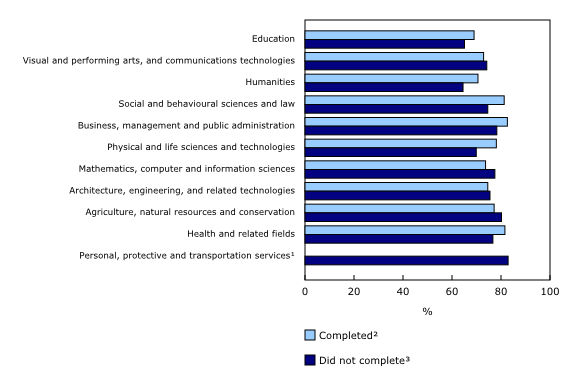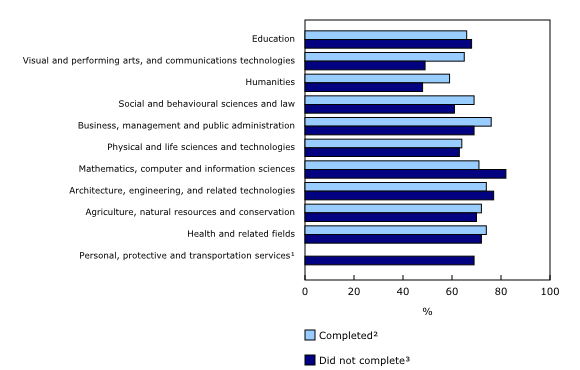Further postsecondary education and labour market outcomes, March 2014
Archived Content
Information identified as archived is provided for reference, research or recordkeeping purposes. It is not subject to the Government of Canada Web Standards and has not been altered or updated since it was archived. Please "contact us" to request a format other than those available.
Released: 2015-09-11
In March 2014, nearly one in four people aged 15 and over with a university degree reported having gone back to school and completed another certificate, diploma or university degree of equal or lower level.
There were 6.5 million people with a university degree in March 2014 and their employment rate was 74.5%. In this release, labour market indicators for those with a university degree are presented by major field of study and then compared with those who completed further postsecondary studies and those who did not.
The employment rate was higher among the 1.5 million university-educated people who completed further postsecondary studies (77.0%) compared with the 5.0 million university-educated who did not (73.7%).
People with a university degree in humanities (31%) or in physical and life sciences and technologies (30%) were the most likely to complete another postsecondary program of an equal or lower level, while those with degrees in mathematics, computer and information sciences or in personal, protective and transportation services were the least likely to complete further studies (18% each).
The three most common major fields of study for people who completed additional postsecondary education were business, management and public administration (27%); education (18%); and health and related fields (13%).
Nearly two out of five people with a university degree who completed another program chose the same field of study as their highest degree. This was particularly prevalent among those who studied business, management and public administration; health and related fields; education; and architecture, engineering and related technologies.
Labour market indicators
By field of study, the largest difference in the employment rate for university degree-holders who completed further studies compared with those who did not was 8.2 percentage points for those who first studied physical and life sciences and technologies (78.1% versus 69.9%). The second-largest difference was 6.7 percentage points for people who had a university degree in social and behavioural sciences and law and who completed further studies (81.3%) compared with those who did not (74.6%).
In terms of wages, 70% of employees with university degrees who completed another postsecondary program earned $800 or more per week, compared with 67% for those who did not.
The largest difference in weekly wages was found for employees whose highest degree was in visual and performing arts and communications technologies, with 65% of those who completed another program earning $800 or more per week, compared with 49% for those who did not. This difference is partly explained by occupational differences: people who completed further studies were more likely to be teachers and less likely to be in sales and service or art, culture, recreation and sport occupations.
For employees whose highest degree was in mathematics, computer and information sciences, the opposite effect was noted, as the proportion who earned $800 or more per week was actually lower among people who completed another program (71%) than among those who did not (82%). This difference is partly explained by occupational differences: people with a math or computer science degree who completed further studies were less likely to be in occupations in natural and applied sciences, and more likely to be in sales and service as well as in art, culture, recreation and sport occupations.
Differences by sex
The proportion of women who completed another postsecondary program after obtaining their university degree was slightly higher than for men (25% versus 22%).
For women who completed another program, the two most common fields for these further studies were business, management and public administration as well as education (24% each). For men with a university degree, business, management and public administration (31%) was the most common field for further studies, followed distantly by architecture, engineering and related technologies (15%).
The unemployment rate of men who completed another program was lower than that of men who did not (3.7% versus 4.9%). For women, the unemployment rate of those who completed another program was slightly higher than that of women who did not (4.6% versus 4.0%).
For both men and women with university degrees, completing another program was generally associated with higher employment rates, as well as higher weekly wages.
For example, among women who had humanities degrees and then completed further studies, the employment rate and weekly wages were higher than among women with the same degree who did not complete further studies. Among women who had a university degree in this field, 72.9% of those who completed further studies were employed, and 59% of employees had average weekly wages of $800 or more. This compares with an employment rate of 60.1% for women who had a university degree in humanities and did not complete further studies, with 41% of them earning $800 or more.
Among men who had a degree in health and related fields, those who completed further studies had a higher employment rate and higher weekly wages compared with men who had a similar degree but did not complete further studies. The employment rate for those who completed further studies was 84.6%, compared with 72.5% for those who did not. For weekly wages, 80% of men with a health-related degree who completed further studies earned $800 or more per week, compared with 65% of men with a similar degree who did not.
Differences by immigrant status
Among university-degree holders, there was no difference in the proportion who completed further studies between recent immigrants (that is, those who landed within the previous 10 years), established immigrants (that is, those who landed 11 or more years earlier) and the Canadian born, at about 24% for the three groups.
The employment rate for immigrants with university degrees who completed another program was 5.4 percentage points higher compared with immigrants who did not (73.4% versus 68.0%). It was 8.8 percentage points higher among recent immigrants who completed another program compared with those who did not, and 3.6 percentage points higher among established immigrants who completed further studies compared with those who did not.
There was a much smaller difference (1.8 percentage points) in the employment rate of Canadian-born with a university degree who completed further studies compared with those who did not (79.1% versus 77.3%).
Note to readers
Data for this release were derived from four questions that were added to the March 2014 Labour Force Survey (LFS), to inform future content discussions for social surveys. These were questions on the field of study of a respondent's highest education, and the completion of any further education after the attainment of their highest level of education.
These questions were: 1) What was the major field of study of the highest certificate, diploma or degree that you completed? 2) Have you completed any other certificate, diploma or degree since you completed your studies in (reported major field of study)? 3) What is the most recent certificate, diploma or degree you have completed? and 4) What was the major field of study of that (recent certificate, diploma or degree)? The respondent's highest level of educational attainment is collected as part of the LFS.
In this article, major field of study is defined using the primary groupings of the Classification of Instructional Programs (CIP).
The unemployment and employment rates presented in this article have not been seasonally adjusted. Therefore, they differ from those derived from the seasonally adjusted data released in the regular LFS publications and thus reflect the employment situation in March 2014.
Despite differences in target population and collection methods between the National Household Survey and the LFS, the overall distribution of the major field of study variable is similar at the primary groupings level of the 2011 CIP. However, there are variations between the two surveys for some field of study and education level combinations that are largely due to differences in coding methods.
For this article, statistical tests were run to measure both the overall quality of the estimates, and whether the differences between groups were statistically significant.
For the sake of brevity, certain category names are shortened for ease of use in the text and graphics. The terms 'further studies' and 'other program' refer to any other postsecondary certificate, diploma or university degree earned since the completion of the highest reported university degree. The completed program must be at least three months in length. The term 'university degree' includes 'bachelor's degree,' 'university certificate or diploma above bachelor level,' 'degree in medicine, dentistry, veterinary medicine or optometry,' 'master's degree' and 'earned doctorate.'
Additional information on education and the labour force can be found in the analytical documents "Education in Canada: Attainment, Field of Study and Location of Study" and "Portrait of Canada's Labour Force," which present results from the 2011 National Household Survey.
Contact information
For more information, contact us (toll-free 1-800-263-1136; 514-283-8300; infostats@statcan.gc.ca).
To enquire about the concepts, methods or data quality of this release, contact Jason Gilmore (613-219-0029; jason.gilmore@statcan.gc.ca), Labour Statistics Division.
- Date modified:



